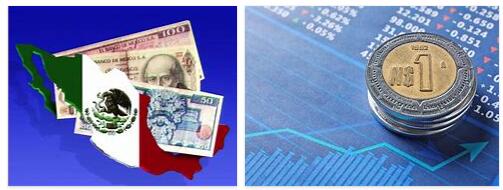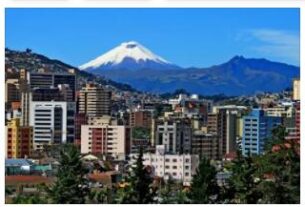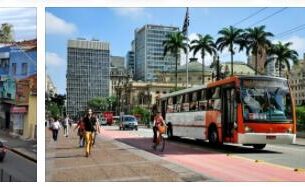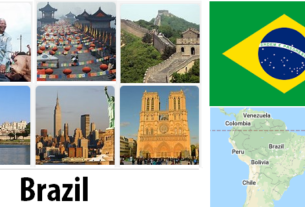The Brazil, the largest and most populous country in South America, with an annual growth rate of ‘ 1, 4 %, reached in 1998, according to one estimate, 165 851 000 residents; according to the forecasts of the UN, it will reach 190 million residents in 2010, and 200 million by 2020. The average density, 19 residents / km ², is of little significance due to the strong regional differences: 72 residents / km ² in the Southeast, which incorporates the immense urban areas of São Paulo and Rio de Janeiro, 29 residents / km ²in the Northeast, very populous on the coast but much less inland, and less than 3 residents / km ² in the North, which includes the Amazonian space; however, the density in the North, from 1970 to 1997, tripled, mainly due to the effect of deforestation and the consequent settlement in the States of Acre, where the population density went from 1 to 2, 9 residents / km ², of Rondônia (from 0, 4 to 5, 6) and of Pará (from 1, 7 to 4, 4); the whole Norte increased the population by 3. 602. 000 (1970) to 11. 590. 000 (1995), largely due to immigration. The phenomenon of urban immigration, unstoppable in the last two decades of the century, has magnified the precarious suburban suburbs of many large centers.
According to behealthybytomorrow, the population tends to become more and more centralized, with rural exodus and the formation of extensive urban suburbs of slums. In fact, the population considered urban, which amounted to 61 % in 1975, reached 80 % in 1997, with a forecast of 90 % for the years between 2002 and 2025. Urban growth in the 1980s and 1990s led to the formation of a littoral megalopolitan region, which includes the two conurbations that belong to Rio de Janeiro (10 million residents) and to Sao Paulo (16, 4 million in 1995, with a urban growth rate of2 % per year) and extends towards the inner plateau, where the urban centers of Belo Horizonte, Juiz de Fora and Riberão Prêto have recently experienced significant growth. Within this leading region of the Brazil, in addition to the major poles, Rio and San Paolo, and the huge cities such as Belo Horizonte (over 2, 2 million residents) and Nova Iguaçu (1, 5 million) not far from Rio, there are dozens of cities that count from 100. 000 to over 500. 000ab., rather well connected by a dense transport network although not always very efficient. San Paolo continues to play the role of main economic center, but various urban centers of the plateau, old or recently developed, have increased and differentiated their industrial potential over the last few decades, while the tertiary sector, also advanced and computerized, is present with a considerable number of employees and fairly efficient networks in the megalopolis of the Center-South.
Urban realities present variegated situations, not comparable to a pre-established model; if in some cases the phenomena of degradation and pollution are evident, especially in the endless poor suburbs whose population figures in the statistics only for approximate estimates, in others, such as that of Curitiba, avant-garde experiments are developed, with urban transport planning and effective environmental protection measures. Curitiba is remembered internationally as an example of recent sustainable urban development, which started from a situation of severe environmental compromise and underdevelopment. Grew up, due to uncontrolled immigration from the countryside that was mechanizing itself, from 300. 000 residents in 1950 a2, 3 million in 1990, with extensive suburbs, Curitiba has implemented a strict schedule, with the pedestrianization of large areas of the center, and fast bus lines from the periphery to the center along preferred routes, connected to many lines shuttle, so that the 30% of those who previously used cars use public transport, and air pollution levels are therefore among the lowest in Brazil. In addition, an updated urban cadastre and monitoring of every corner of the municipal area allow interventions in real time. The waste problem has been tackled by involving the population in low-cost financial programs but of great substantial impact, such as widespread separate collection in homes, and – in the poorest neighborhoods – the sale of waste in exchange for notebooks, bus tickets., food rations, controlled assistance to children and the most disadvantaged families.
About 5 million cars circulate in the crowded metropolitan area of San Paolo ; the regional authority has started building a network of 300 km of cycle paths to boost alternative transport. City and a lower peripheral time – like Manaus on the Amazon River (1, 3 million pop.), The capital of Amazonas, or Goiânia (1, 1 million), capital of the State of Goiás, in the interior to a few hundred of km from Brasilia, or also Belém (2millions) on the Baia de Marajó, the southern branch of the Amazon River estuary – they have grown faster than average also due to uncontrolled immigration. Brasilia itself, the federal capital deliberately built on the internal plateau to signify the projection of the Brazil towards the northern territories, as opposed to the ancient urbanized coastal port strip resulting from European colonialism, was planned in the 1960s for a population of 600,000 ÷ 700. 000 residents, while it has over 1. 800. 000 (1995), because large poor neighborhoods have also formed around it, mainly due to immigration from the countryside and from smaller towns. The growth of the great cities of the Northeast, emblem of the underdevelopment of Brazil (such as Recife, 1, 3 million residents, Fortaleza, 1, 8, and Salvador, over 2), historical capitals of the first colonization and of the greatest forced influx in the secc. 17th and 18th of African blacks, is due more to the high birth rate than to immigration which, however, also swells here large neighborhoods of slums and favelas. These data fall short of reality, which is not fully officially controlled.



